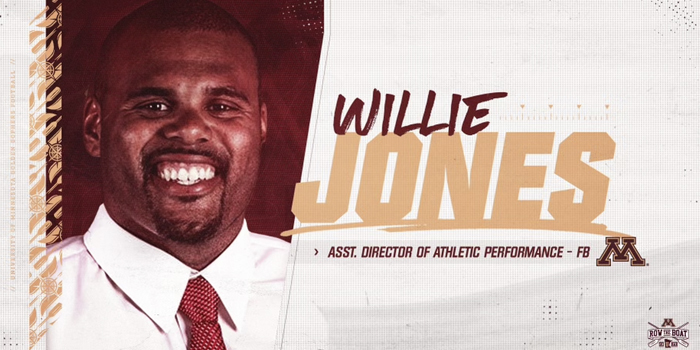
I met Willie at the University of Illinois in 2017 when I visited my friend Joey Boese. Joey was the Head Coach for Strength and Conditioning at the University of Illinois at the time.
Getting to know Willie over the years has been great. Willie has since moved into another GREAT program at the University of Minnesota as the Assistant S&C coach. Today, we will do some Q&A and get to know him and better understand what it takes to coach at such a high level.
Can you give the readers some background information about yourself?
Thank you for asking me to speak with you. I appreciate it. I grew up in South Dakota and played football at South Dakota State University. I graduated with a bachelor's and a master's degree from there in 2007 and 2012.
I studied exercise science and was a graduate assistant strength and conditioning coach from 2007 to 2009.
After school, I spent seven years at the University of Nebraska as an Assistant Strength and Conditioning Coach. After my time in Lincoln, I took a job at The University of Illinois, where I was an Associate Strength and Conditioning Coach for five years.
I am currently the Assistant Director of Athletic Performance here at Minnesota.
For some, if not most, the readers might not understand the daily schedule and grind you guys have at this level (POWER 5) of coaching. Can you walk us through a typical day?
Absolutely. Depending on the time of year, the schedule can be more rigorous than other times. In-season, for example, we lift and practice in the morning, so everything is done by noon. The day starts for me with a 4:30 AM wake-up call. I am in the facility around 5:00 AM. We set up the weight room around 5:30 AM, and the lift starts around 6:30 AM.
We have a team meeting at 7:45 AM and then practice starts around 9:30 AM. I am usually out of the building on practice days around 5:00 PM. In the off-season, it is dependent upon places I have been, but typically we have two early morning run groups then four lift groups throughout the day. That is usually four days a week during the off-season. At times it can be a grind, but I love every minute of it.
The Strength and Conditioning Coach probably spends the most time with the collegiate athlete. Can you break down a yearly plan such as the macrocycle, mesocycle, and microcycle?
It might make more sense to break down the times of the year because each one differs depending on the time of year you are in.
So, in-season, we train the two-deep (guys that play) twice a week during the season. One day is a lower body day, and the other is an upper body day.
The non-two-deep (guys that play on special teams) train three days a week. The developmental (usually freshmen) and second-year guys that don't play will train four days a week in-season. We consider this the most crucial time for them because it is the longest period of time they will get to train throughout the entire year.
Winter training is typically between five to eight weeks, depending on when the head coach wants spring ball to start. That will usually be January through March. We will train four days a week during this time period with four days of running and lifting. This time is also vital because we don't practice during this time. This time is completely devoted to lifting, running, and player-led practices. We control the volume and intensity.
For Spring ball, the emphasis shifts back to the field. We will practice three to four days a week and train two to three days on non-practice days. This time period typically lasts around one month.
Summer serves as the preparation for fall camp. Our conditioning volume will be a lot higher during this period, especially in July. We have to get the guys in shape to handle practices, so we train four days per week. We will lift and run on all four of these days. Two days a week will have a linear and lateral speed emphasis, and two days a week will have a conditioning emphasis.
Can you give the reader, who aspires to move up in their ranks to the Division 1 level, any suggestions or recommendations?
Anyone trying to get to the Division 1 level needs a great work ethic. They must be willing to do what is asked and to take the initiative to get things done that aren't necessarily asked of them.
Ultimately, they probably need to try and get an internship somewhere. Knowing someone at this level can help get you in the door. What you know can help keep you there.
Make sure you establish a positive working relationship with co-workers and the athletes. Not being so rigid in your approach and adapting on the fly are all vital characteristics.
What are some positives and negatives of working in the strength and conditioning field?
Positives
I get to work with young people on a daily basis and help them achieve their goals. Therefore, I learn from incredibly talented people and become the best strength coach I can be. I train people for a living; it doesn't even seem like a job!
Negatives
It's tragic when talented athletes don't reach their potential because they don't work hard or throw it away.
As a top-ranked super-heavyweight, Chris Janek earned the nickname “Tank.” As a two-time all-state wrestler as well as an all-state, third team all-American football player he received multiple full-ride scholarship offers, choosing to play football for the University of Wisconsin. During his collegiate football career, Janek was a four-year letter winner as well as a two-year starter. He was part of four Bowl Games (two Rose Bowls, in which they won). After college, he furthered his football career with a tryout with the Cleveland Browns and an eight-year career in the now-defunct Arena Football League. He is the owner of Tanks Training Facility in Granite City, Illinois and has devoted himself to multi-ply powerlifting. In 2010, Janek totaled 2660 to win best lifter at the GPC Worlds (in Prague). In 2014, he won first place and best lifter overall at the XPC Finals with a 2725 total.










